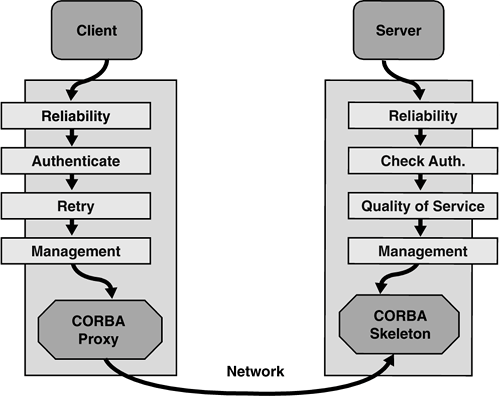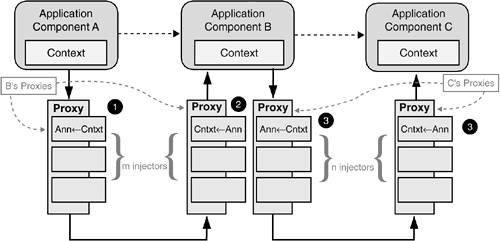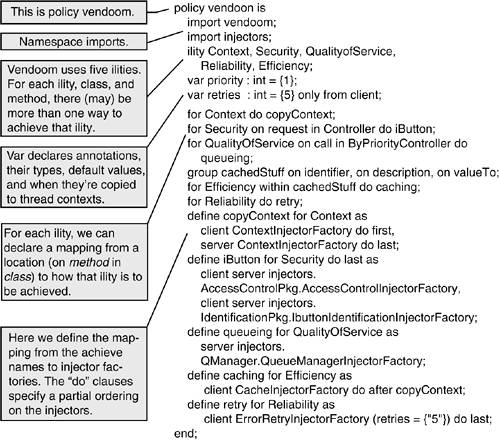Section 13.2. OBJECT INFRASTRUCTURE FRAMEWORK
13.2. OBJECT INFRASTRUCTURE FRAMEWORKWe have illustrated these ideas by defining an architecture (the Object Infrastructure Framework or OIF), instantiating that architecture for a particular environment (CORBA®/Java™), and creating several validating applications within that framework [2, 8]. Current technology for building distributed, component-based applications uses sockets, messages, remote procedure calls such as DCE™, or Object Request Brokers (ORBs, such as CORBA, JavaRMI™, and DCOM). Without too much loss of generality, we focus on ORB frameworks and use CORBA as our exemplar. CORBA implements distribution by building proxy objects on both the client (caller environment) and server (called environment) to represent a particular server object. The client-side proxy (or stub) is responsible for marshaling a client request into a form that can be transmitted over the network; the server-side proxy (or skeleton) demarshals the request into native data structures for the server to process. ORB technology provides object location transparency and hides the details of marshaling and communication protocols. What it doesn't do is handle ility concerns like partial failures, security, and quality of service. ORBs such as CORBA and Enterprise JavaBeans™ provide different discrete mechanisms for particular ility issues, but such mechanisms typically provide only a finite number of choices for the application architect, and require a good understanding and diligent application of the mechanism by the application programmer. 13.2.1. InjectorsOIF's key implementation idea is to modify ORB proxies so that: (1) each stores a map from proxy methods to a sequence of injectors, and (2) in the proxy processing for a given method, that sequence is invoked between the application and marshaling. The action method of the injector gets an object representing the request. It can interrogate and modify that object for the request's target, method name, arguments, and annotations. Being code, it can perform arbitrary other operations, such as invoking methods on other (remote) objects and changing its local static state. Figure 13-2 illustrates CORBA proxies extended with injectors. Figure 13-2. OIF inserts injectors between the application and the network.
Injector processing is in "continuation style," meaning injectors invoke the rest of the injector sequence between their "before" and "after" behaviors. (With the continuation pattern, one of the parameters of a routine is a representation of "the rest of the work to be done" after this routine has finished. In OIF, the continuation is represented as a list of injectors, and invoking the continuation is simply calling the first injector in this list, providing it the rest of the list as its continuation.) This has the advantages of allowing the injector stack to naturally catch exceptions, and permitting an injector to forgo or transform the continuation sequence. Our authentication injector illustrates the former advantage. A server-side authentication injector dissatisfied with a request's credentials raises an exception that a client-side injector catches. The client side injector interrogates the user and reinvokes the request with the additional annotation. Similarly, when methods return static values and do not have side effects, an injector can cache values returned from previous calls. When a request is already in the cache, the caching injector can omit the remote call and return the local value. This has the effect of doing "objects by value" for selected parts of a remote object. 13.2.2. AnnotationsAnnotations provide a language for applications and injectors to communicate regarding requests. That is, they are a meta-language for statements about requests and the processing state. Annotations can express notions like "This request is to be done at high priority," "Here are the user's credentials," and "Here is the cyberwallet to pay for this request." Annotations can be associated with both requests (request annotations) and processing threads (thread contexts). OIF annotations are name-value pairs. The names are strings and the values are CORBA ANY types, allowing object references as annotation values. This requires annotation readers and writers to have an implicit agreement about annotation types. Object references in annotations are used for patterns such as continuations ("Send the results of this computation to X") and agencies ("Y can verify my identity"), but not strings; encoding object references as strings would burden the recipient with demarshaling. The framework defines certain common annotations, including session identification, request priority, sending and due dates, version and configuration, cyber wallet, public key, sender identity, and conversational thread. Programs can rely on the common meanings of these annotations. Applications and injectors can create other annotations. Annotations can be implemented as hash tables or property lists. OIF proxies marshal and demarshal request annotations like ordinary procedure arguments. Requiring injectors to declare the annotations they read and write, and enforcing those declarations, can improve security. We may feel safer using an injector that is restricted to only read the due dates of messages rather than one that can alter user identification or method arguments. Thread contexts, (annotations associated with processing threads), allow applications to communicate with injectors. On each call, the framework copies the client thread's annotations to the annotations of the nascent request. On the server side, the framework builds the context of the service thread from the request's annotations. On return, the framework copies the server's context to the annotations of the response and then back to update the context of the original client. This scheme has the feature of propagating context through a chain of calls: Client A's call of B at priority x becomes B's context's priority of x. B's request of C (in furtherance of A's call) goes out with priority x. Figure 13-3 illustrates this pattern. Figure 13-3. Propagating annotations. |
EAN: 2147483647
Pages: 307


